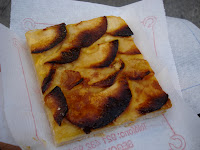I could write/talk about the food in Spain forever. I certainly miss my favorite foods in Alaska (a Moose's Tooth pizza sounds fantastic right now), but I am reveling in the new food territory that surrounds me. It doesn't hurt that my host mom is a fantastic cook. She has been making all sorts of foods that are typical of Spain, partly to give me a chance to try them all.
My favorite by far has been paella. I have only had my host mom's paella (a rice and seafood dish), and I have no desire to try any other. It is rich and super hearty. Her paella is filled with all sorts of seafood (some of which I wouldn't have touched at home), fish, and sometimes chicken. It is a beautiful red color that comes from the tomatoes and the red peppers (and someone told me that some people put saffron in paella). Something I find interesting about it is that I don't think my host mom cooks the rice before making the paella, so although the rice is cooked in the paella, it retains a little firmness, which gives it a lot of contrasting textures. I am determined to learn how to make it before I return home.
I also tried croquetas, which are fresh cheese covered in bread crumbs and fried. They are delectable! I don't know if I can get this type of cheese in the U.S. but I will definitely try to find a way to make them. They are crispy on the outside, and the inside is viscous, between liquid and solid. The cheese itself doesn't have a strong flavor, but it tastes something like fresh milk.
My host mom also makes a bizcocho (cake) that she flavors with either lemon or orange. She gave me the recipe and I am super excited to try it out. The other day, she put some of the orange bizcocho in a custard (which if you know me well, you know I absolutely love) and topped it with cinnamon (she called it natilla). This cinnamon was nothing like the cinnamon I've had in the states, and I finally truly believe what I've heard about cinnamon on cooking shows. Basically, the cinnamon in the states is not really authentic cinnamon, and to get real cinnamon your only option is to order online (so the cooking shows told me). I was a skeptic, but I have now tasted what real cinnamon is, and I don't think there is any turning back for me.
This week, I have been on vacation, and I have been making it a priority to visit all the different pastelerías (pastry shops) in Segovia and try all the different sweets. I will break down all the things I have tried so far.
Tejas: Melted sugar and nuts (I think they might be hazelnuts but I'm not sure), that have been molded into a curved shape (like curved roof tiles). Crunchy, sweet, and delicious.
Coca de piñones: A cracker with no sweetening or flavoring topped with caramelized sugar and pine nuts. I never really thought about making something sweet with pine nuts, but it was fantastic, and I will definitely have to try it when I return home.
Lemon cake: This one didn't have a specific name, I asked. It was a lemon flavored cake with a creamy topping. I expected it to be unbearably sweet, the way frosting is in the U.S., but it was pleasantly light.
Pastelillo de manzana: My host dad asked me one day at lunch if I knew how to make "American Pie," by which he meant apple pie. He told me that there was a version of apple pie that was made in Spain and wanted to know if it was different. I have now tried the Spanish version of apple pie and it is indeed different from American Pie. For one thing, there is only crust on the bottom (which is really tender), and it is square. Aside from these superficial differences though, the apple tart here doesn't features spices like cinnamon and allspice. The filling is just apples and sugar (which isn't better or worse, just different-you can taste the apples themselves a little more).
Rosquilla de Anis: A crunchy cookie featuring anis seeds and coated in sugar. It was really good, and very much like a tea biscuit; flaky and it melted in my mouth. It went fabulously with my cup of coffee (The coffee here is delicious! Except at the fast food restaurants).
Chuches: Candy from a chuchería (a candy shop). They look the same as the candy in the shops in the U.S. There are things that could be Swedish Fish but are really men; there are licorice strands, and things that look like jelly beans. But everything tastes different. Most of the candies that I tried are gummies and I thought I was grabbing the sour ones but it seems that sour candy is as popular here are it is in the U.S. Nevertheless, they were quite sugary and very much like candy everywhere.
That is an update of my food adventures so far. I will definitely keep posting more about the food in Spain; I am thrilled to be trying so many new things!
'Ta Luego!















